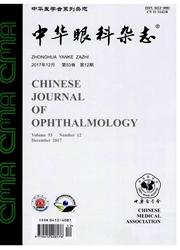

 中文摘要:
中文摘要:
目的探讨带巩膜环全角膜移植术后免疫排斥反应的特征及其抗排斥治疗的转归。方法回顾性分析2003年7月至2005年7月在我院行带巩膜环全角膜移植术且术后有完整记录的14例患者临床资料。患者入选标准:术后1周时角膜植片透明,前房深度正常,眼压与B超检查正常,1周后发生了临床似免疫排斥症状的患者。对所选患者的排斥发生时间、视力变化、症状、体征及治疗后转归等情况进行分析。结果首次免疫排斥出现在术后11~13d(2例),2周至1个月(10例),3个月(1例),6个月(1例)。发生排斥时所有患者1~2d内视力由术后0.05~0.2急剧下降至眼前数指或手动;患者有畏光、流泪等眼部刺激症状;角巩膜缘充血水肿,血管迂曲怒张,甚至成暗红色淤血或结膜下出血样改变;全角膜植片水肿混浊、增厚,后弹力层皱褶,前房变浅;未发现上皮排斥线、内皮排斥线及角膜后沉着物(KP)。免疫排斥发生时,12例患者眼压明显降低,<10mmHg。5例患者B超显示视网膜脉络膜水肿。发病3d内,7例患者就诊,经抗排斥治疗后角膜植片均恢复透明。发病3~5d,有3例患者就诊,其中2例角膜植片恢复透明,1例发生角膜植片内皮功能失代偿。发病7d及以上,4例患者就诊,其中1例角膜恢复透明,2例发生角膜植片内皮功能失代偿,1例眼球萎缩。结论带巩膜环全角膜移植术后免疫排斥反应的临床特征为:发生早,视力骤降;角巩膜缘血管迂曲怒张,全角膜植片水肿;前房变浅,眼压降低等。及时就诊和有效的抗排斥治疗将直接影响患者的预后。(中华聪科杂志,2007,43:589-593)
 英文摘要:
英文摘要:
Objective To study the clinical characteristic of immune rejection after corneoscleral transplantation. Methods A retrospective study was performed on patients received eorneoseleral transplantation in Shandong Eye Insititute between July 2003 and July 2005. 14 cases were included in this study. Enrollment criterion: on the 7th day postoperatively, graft was transparent; depth of anterior chamber, intraocular pressure (IOP) and B scan were normal. The time, vision, symptom, characteristic, and outcome of immune rejection were recorded. Results The time and incidence of immune rejection were as following: 2 cases from day 11 to day 13; 10 cases from weeks to 1 month; 1 case in 3 months and 1 case in 6 months. Vision acuity decreased from 0.05 - 0.2 to finger counting (FC) or hand motion (HM) in all of cases with immune rejection; the major manifestation of immune rejection were circular limbal congestion, edema with circuitous and dilated vessel; the other characteristics of the rejection included whole graft edema, descemet membrane folds, shallow anterior chamber; endothelial rejection line or keratic precipitate (KP). IOP reduction 〈 10 mm Hg was seen 12 patients. Retina and choroids edema were found in 5 patients using B scan. After the diagnosis of immune rejection was established, 7 patients were treated with anti-rejection medication within 3 days, their grafts became transparent; 3 patients were treated within 3 - 5 day after the rejection, 2 grafts became transparent, 1 graft was suffered from endothelium decompensation ; 4 patients were treated 7 days later after the rejection, 1 graft became transparent, 2 grafts were suffered from endothelium decompensation and 1 eye was atrophied. Conclusions After corneoscleral transplantation, the characteristic of immune rejection includes circular limbal congestion, whole graft edema, shallow anterior chamber and low IOP. Immediately anti-rejection treatment is critical for the prognosis after immune rejection. (Chin J Ophthalmol , 2007,43?
 同期刊论文项目
同期刊论文项目
 同项目期刊论文
同项目期刊论文
 期刊信息
期刊信息
